Sleep is an extremely complex, dynamic process, and yet to be well understood even after decades of intensive research. Some animals seem to thrive on 2 hours of sleep per day, while others must remain unconscious for most of their lives. While certain functions of sleep have been identified or theorized, sleep researchers are still trying to understand the underlying evolutionary purpose of snoozing. And so far, scientists aren’t really sure of the reason behind the massive variation in sleep patterns, especially among mammals.
In this guide, we’ll discuss 10 animals that sleep the most and the least, with five from each category, starting with those that catch the most Zs.
Animals That Sleep the Most: Brown-Throated Sloth (Bradypus variegatus)- 15 to 18 Hours
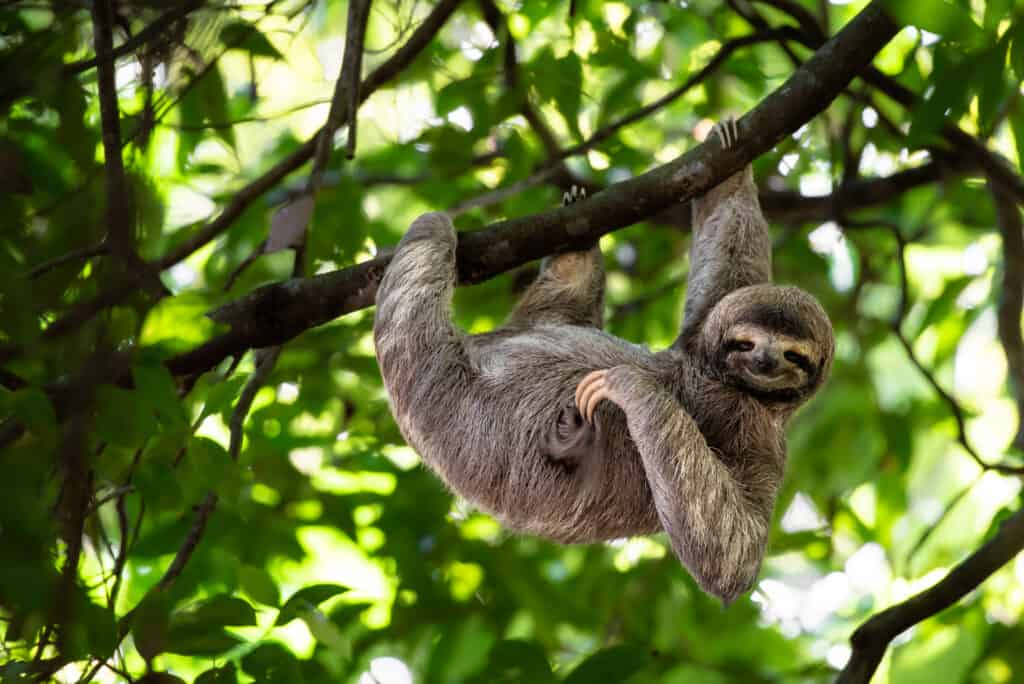
The sleepy brown-throated sloth snoozes for about 15-18 hours in 24 hours.
©Lukas Kovarik/Shutterstock.com
The brown-throated three-toed sloth (Bradypus variegatus) inhabits neotropical rainforest regions of Central and South America. These sleepy, slow-moving tree-dwellers typically sleep 15-18 hours per day on average.
Although primarily active during the day (diurnal), this species of sloth can be distinctly flexible in its activity patterns. Depending on its environment, nearby predator populations, and food availability, it can adapt to a nocturnal or cathemeral (active during parts of the day and night) activity pattern.
Owl Monkey (Aotus spp.)- 17 Hours

Nocturnal, the owl monkey sleeps for about 17 hours in social groups from dawn until early night.
©Marek Stefunko/iStock via Getty Images
Also known as the night monkey, the owl monkey (Aotus spp.) is the only nocturnal genus of true monkeys. These unique primates inhabit rainforest regions of Central and South America. They feed at night among the tree canopy, foraging fruits, flower nectar, vegetation, insects, and occasionally small birds and mammals.
When they’re not active, the owl monkey sleeps in family groups in tree hollows, dense brush, or vine-covered trees.
Animals That Sleep the Most: North American Opossum (Didelphis virginiana)- 18 Hours

The North American opossum spends about 18 hours per day asleep.
©Bsheridan1959/iStock via Getty Images
Primarily nocturnal, especially in ideal environments when food is abundant, the North American opossum (Didelphis virginiana) typically spends their days snoozing. When healthy, this northern marsupial racks up an average of 18 hours of sleep daily.
Highly nomadic, the North American opossum tends to stay on the move at night, scavenging and finding suitable places to sleep during the day. Their homes include abandoned dens, hollow logs and trees, burrows, open crawl spaces, bushes, and brush piles.
Male African Lion (Panthera leo)- 18-20 Hours

Male African lions spend 18-20 hours sleeping per 24-hour period.
©Gerrit_de_Vries/iStock via Getty Images
While their female counterparts average 15-18 hours of sleep, male African lions (Panthera leo) spend 18-20 hours per day on average snoozing. Most active from dusk to dawn, these big cats primarily spend their days sleeping in the shade.
Since healthy adult African lions have no natural predators, they can sleep out in the open among diurnal animals. It’s not unusual for researchers to spot a massive male lion sleeping belly up with his paws in the air! As highly social animals, they can also take turns sleeping while other members of the pride keep a watchful eye on their cubs and surroundings.
Animals That Sleep the Most: Koala (Phascolarctos cinereus)- 18-22 Hours
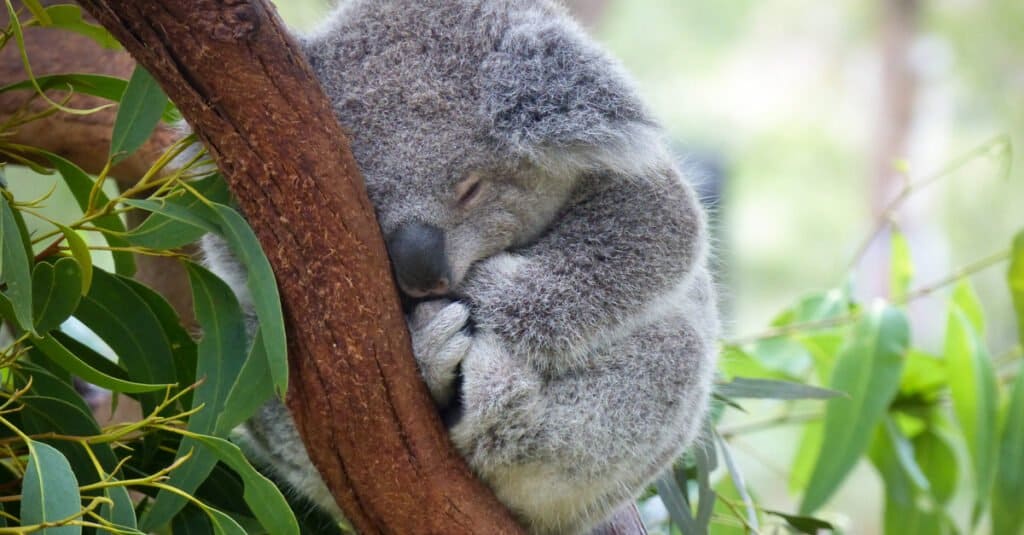
Koalas must sleep long hours to conserve energy and digest their nutrient-poor diet of eucalyptus leaves.
©Richard A Wall/Shutterstock.com
Like sloths, the koala (Phascolarctos cinereus) is well-known for their sleepy lifestyle. Due to their low-energy diet of eucalyptus leaves and intensive digestion process, koalas sleep up to a staggering 91.67% of their lives! On average, this Australian marsupial sleeps 18-22 hours per day.
Primarily active around night and dawn (albeit for only 2-6 hours), arboreal koalas feed almost exclusively on the leaves of eucalyptus trees. Eucalyptus leaves are quite toxic and require an intensive digestion process to render them edible. Koalas house unique microbial communities in their distinctly long caecum that are key to digesting this toxic plant material. This intensive digestion process occurs during their long hours of slumber.
Animals That Sleep the Least
A 2005 study published in Nature found possible links between the size of an herbivorous mammal and the amount of sleep needed, with hours of sleep per day often decreasing as body size increased. In mammalian predators, the relationship between size and sleep doesn’t seem to correspond as closely.
One theory for why large herbivorous mammals sleep so little is that they need to devote the majority of their time to consuming enough calories. These large mammals also tend to have slower body and brain metabolic rates, which researchers in a 2007 study propose is linked to reduced sleep requirements. This is because higher metabolic rates can lead to increased cellular damage, which requires longer periods of rest for the brain to repair. Lower metabolic rates among large herbivores, therefore, the researchers posed, result in less cellular damage and a decreased sleep requirement for cellular repair.
Animals That Sleep the Least: Grey Seal (Halichoerus grypus)- 6 Hours
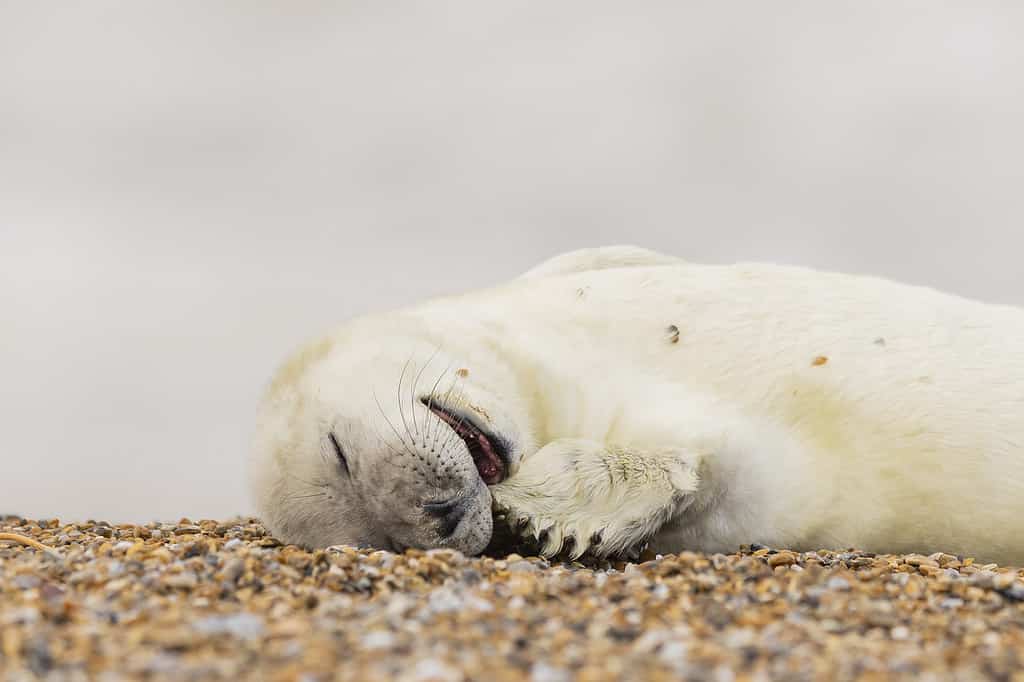
The
grey seal
sleeps about 6 hours in bursts of about 30 minutes at a time.
©Leila Coker/iStock via Getty Images
The grey seal (Halichoerus grypus) inhabits temperate and subarctic waters of the North Atlantic. Their ideal habitat is a rocky coastline situated near small islands and reefs. These diurnal marine mammals are active during the day and primarily sleep during the night.
Grey seals have adapted a range of sleeping behaviors. They can sleep vertically in the water with their heads bobbing above the surface or even completely submerged underwater for 20-30 minutes at a time. On land, they sleep on ice and along the coastline, where they also tend to sleep in short bursts to avoid predation better. In total, grey seals sleep about 6 hours in a 24-hour period.
Domestic Goat (Capra hircus)- 5 Hours

Social sleepers, the domestic goat often curls up for naps in groups.
©WHPics/iStock via Getty Images
The domestic goat (Capra hircus) is a diurnal animal most active in the morning and early evening. They will take short naps during the day, but these ruminants primarily sleep at night for up to 5 hours in a 24-hour period.
They will sleep both standing up or lying down, although they only doze for brief periods while standing. Typically, goats are more likely to sleep lying down when they feel safe, and other members of the herd are on watch. It is during this time that they achieve deep, restful sleep. Goats are social sleepers and often cluster together to rest.
Animals That Sleep the Least: Giraffes (Giraffa spp.)- 4 Hours
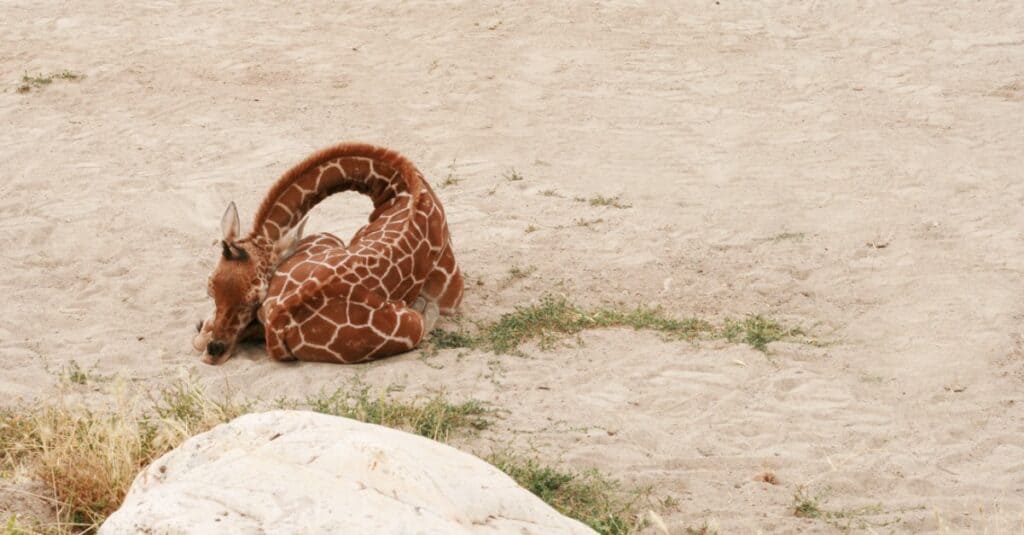
In a 24-hour period, giraffes will sleep for about 4 hours over the course of short naps.
©iStock.com/jandeejones
While they may be the tallest animal on the planet, the giraffe (Giraffa spp.) gets some of the shortest sleep of any mammal. In a 24-hour period, giraffes will typically sleep about 4 hours.
To better protect themselves, giraffes sleep in short cycles of up to 35 minutes, primarily at night, with most naps averaging only about 5 minutes at a time. They typically sleep lying down with their long neck curled around and their head resting on their rump. During the day, they may sleep for a few minutes while standing up.
Donkey (Equus asinus)- 3 Hours
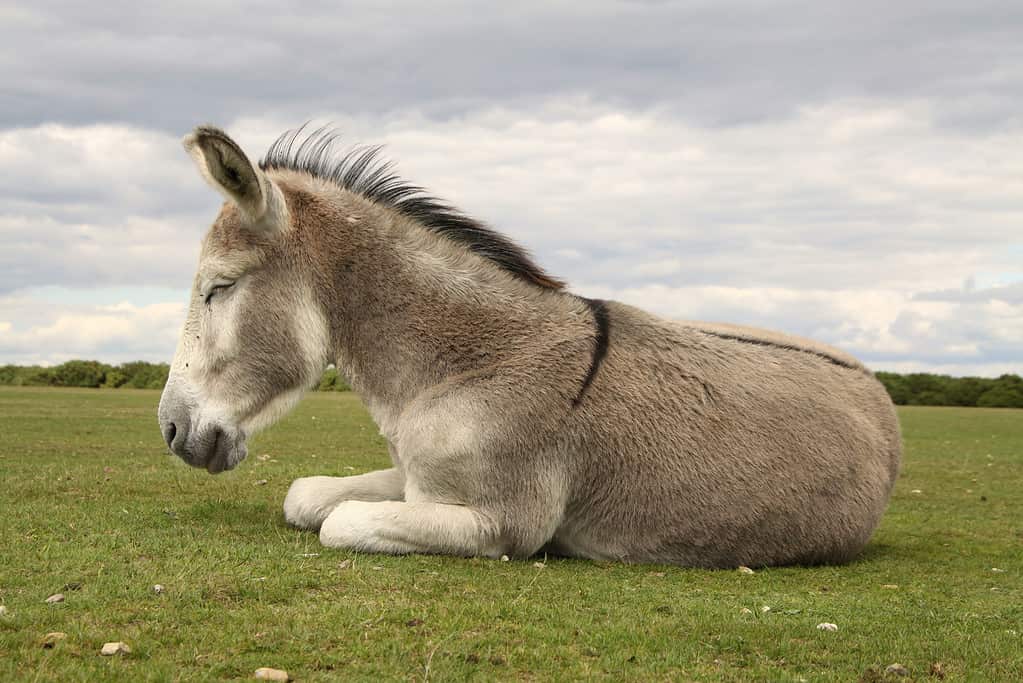
Donkeys typically sleep lying in an upright position with their legs curled underneath.
©rosalind morgan/iStock via Getty Images
Domesticated and wild subspecies of donkeys (Equus asinus) all generally sleep about 3 hours per 24-hour period. These highly social, diurnal animals tend to sleep in groups at night, with individuals taking turns watching for threats.
To enter the REM cycle of sleep, donkeys must be lying down. They rarely sleep on their side and instead lay in an upright position with their legs curled underneath.
Animals That Sleep the Least: African Elephant (Elephantidae)- 2 Hours
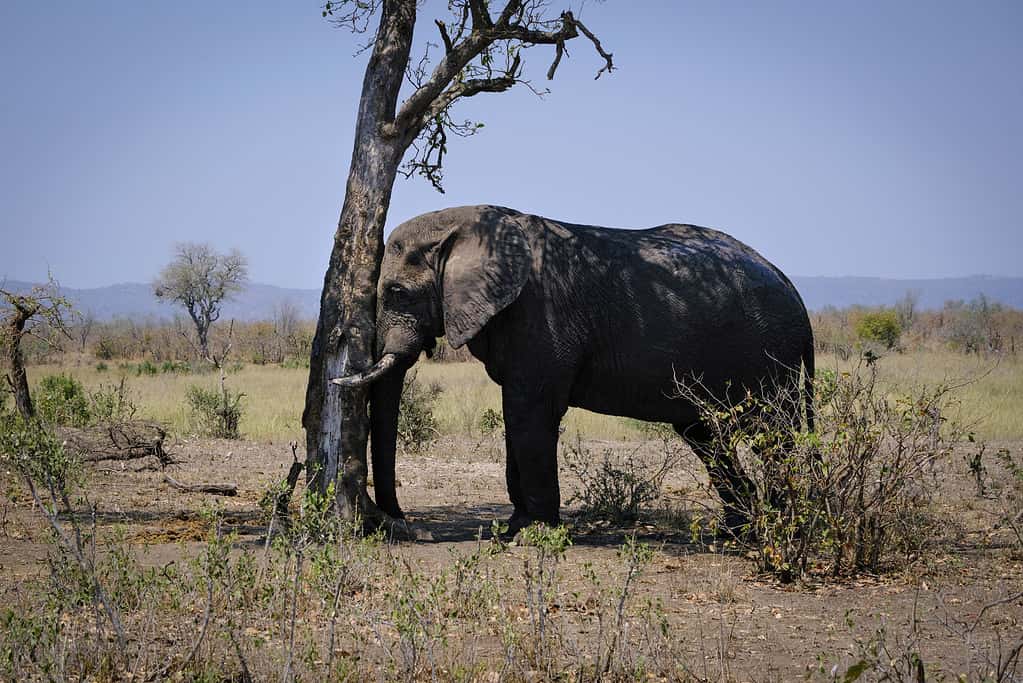
The African elephant is one of the shortest sleepers of all mammals.
©Wirestock/iStock via Getty Images
In the wild, the magnificent, massive African elephant (Loxodonta africana) requires a mere 2 hours of sleep in a 24-hour cycle. These primarily diurnal animals get most of their sleep at night, although they will also nap briefly during the day.
Highly social and living in bonded family units, African elephants take turns sleeping to ensure protection from opportunistic nocturnal predators. Typically, adults will sleep standing up in bursts of 5-30 minutes at a time. Calves are more likely to sleep lying down on their sides while their adult family members watch over them.
The photo featured at the top of this post is © myphotobank.com.au/Shutterstock.com
Thank you for reading! Have some feedback for us? Contact the AZ Animals editorial team.






